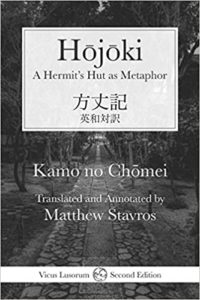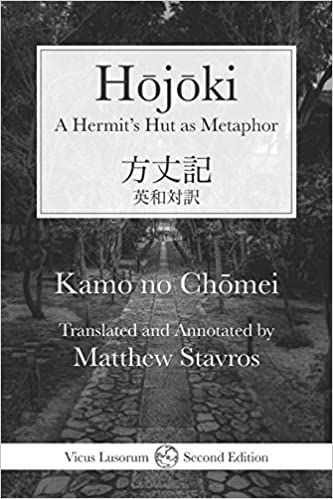Review by Leanne Ogasawara
The Hōjōki, written in 1212 by the Buddhist monk Kamo no Chōmei, is one of the most beloved works of medieval literature in Japan. The opening lines of his chronicle are familiar to most Japanese people:
The flow of the river never ceases
And the water never stays the same.
Bubbles float on the surface of pools,
Bursting, reforming, never lingering.
They’re like the people in the world and their dwellings.
Japanese Buddhist literature is filled with the struggle to overcome the pain of transience. There is no escape, as we all know, for bad luck is an equal-opportunity act.
In a country that is no stranger to calamities, the late 12th century was particularly rough. Devastating earthquakes and fires, windstorms and famine were exacerbated by continued political upheaval and violent battles in the streets. Chōmei watched as the capital of Kyoto was rocked by a mega-earthquake, in which “mountains crumbled, filling rivers with rubble,” and then later as disease and famine meant “starved bodies lay strewn about the street…” Horrified by the suffering and anguish of this broken world, he decided to leave the capital and take up a life of contemplation in the mountains. For, as the great literati of China before him knew all too well, when the going gets tough, the wise head for the hills!
Eight hundred years later, as we are facing our own calamities in the form of a worldwide pandemic and endless political instability, historian Matthew Stavros, an academic at the University of Sydney and former director of the Kyoto Consortium of Japanese studies, has just released a new translation of this Japanese classic.
The Hōjōki has already been translated several times, notably by Burton Watson in his book Four Huts, published by Shambhala in 1994. This edition contains four famous works by Buddhist recluses, including Bai Juyi (or Po Chü-i), Matsuo Bashō and Yoshishige no Yasutane as well as beautiful brush paintings by artist Stephen Addiss. Another prominent translation from the 1990s was by Kyoto-based translators Yasuhiko Moriguchi and David Jenkins. Stavros’ new translation is marked by the literary quality of his English. Choosing to render Chōmei’s prose into verse, the English is lyrical and sounds beautiful when read aloud (there is a wonderful narration by MG Miller on Audible). The text is complemented by photographs of Kyoto taken by the author.
Opening the pages of the Chronicle, readers journey along with Chōmei, the sixty year-old Buddhist monk, as he leaves his privileged life of rank in the capital and builds his very simple hut “deep in the hills of Hino”. In contrast to the endless string of calamities that filled the pages of the first part of his book, the second section details the great pleasure he takes in his new home:
In the spring,
Wisteria flowers bloom like purple clouds in the west.
In summer,
The chattering cuckoos guide me,
Toward the mountain pass of death.
On autumn evenings,
The cries of cicadas fill my ears,
Lamenting this empty husk of a world.
And when the winter comes,
Snow covers the earth.
The book gets its name from Hōjō 方丈, an architectural term representing one square jō 丈—about ten-foot square. This word, conveying a small, cell-like space, is also used to describe a monk’s living quarters, especially in the Zen tradition. The hut is tiny, but somehow there is a living area, along the eastern wall in the form of his “dried bracken for a bed”. This bed is but a hand’s reach away from his musical instruments—his lute and koto—that sit beside a shelf holding his music and poetry, and a few books, “like Genshin’s The Essentials of Rebirth in the Pure Land”. This is the section of the hut assigned for the arts:
A little to the west,
There’s a shelf for offerings,
Not far from an icon of Amitabha.
When bathed in evening light
A warm glow emanates from Amitabha’s forehead.
And so, Chōmei—born to privilege and talent—gives it all up to become a Buddhist recluse in the Hills of Hino. And there, in his ten-foot square hut, he realizes that everything in the world comes down to the state of one’s mind. As he says, rendered so beautifully by Stavros:
Palaces and mansions:
If the heart is not at ease,
These worldly treasures bring no pleasure.
I love my lonely dwelling,
This simple, one-room hut.
About the reviewer
Leanne Ogasawara has worked as a translator from the Japanese for over twenty years. Her translation work has included academic translation, poetry, philosophy, and documentary film. Her book reviews have appeared in Kyoto Journal, the Dublin Review of Books, the New Rambler, and 3 Quarks Daily.
This review was first published in Asian Review of Books


